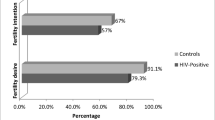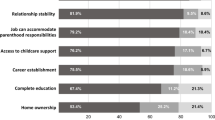Abstract
The reproductive desires of HIV-positive men have been investigated far less than those of HIV-positive women, especially in the US. This qualitative study of a sample of 94 HIV-positive men in New York City who were in a relationship with a woman of reproductive age examined their reasons for wanting a child as well as the conditions under which they would feel ready to attempt conception. Participants felt a child would make them feel normal, give meaning to their lives, or make others in their life happy. Although they reported HIV-related concerns (i.e., horizontal or vertical transmission, reinfection, or shortened life expectancy), participants mostly discussed factors unrelated to HIV (e.g., finances, housing, incarceration, substance abuse, or relationships) as deterrents to acting on their desire to having a child. When providing information on safer conception, healthcare providers should be aware of the broad desires and factors informing HIV-positive men’s reproductive goals.
Similar content being viewed by others
References
Marcus JL, Chao CR, Leyden WA, et al. Narrowing the gap in life expectancy between HIV-infected and HIV-uninfected individuals with access to care. J Acquir Immune Defic Syndr. 2016;73(1):39–46.
May MT, Gompels M, Delpech V, et al. Impact on life expectancy of HIV-1 positive individuals of CD4+ cell count and viral load response to antiretroviral therapy. AIDS. 2014;28(8):1193–202.
Samji H, Cescon A, Hogg RS, et al. Closing the gap: increases in life expectancy among treated HIV-positive individuals in the United States and Canada. PLoS ONE. 2013;8(12):e81355.
Trickey A, May MT, Vehreschild J-J, et al. Survival of HIV-positive patients starting antiretroviral therapy between 1996 and 2013: a collaborative analysis of cohort studies. Lancet HIV. 2017;. doi:10.1016/S2352-3018(17)30066-8.
Sauer MV, Wang JG, Douglas NC, et al. Providing fertility care to men seropositive for human immunodeficiency virus: reviewing 10 years of experience and 420 consecutive cycles of in vitro fertilization and intracytoplasmic sperm injection. Fertil Steril. 2009;91(6):2455–60.
Matthews LT, Smit JA, Cu-Uvin S, Cohan D. Antiretrovirals and safer conception for HIV-serodiscordant couples. Curr Opin HIV AIDS. 2012;7(6):569–78.
Little KM, Taylor AW, Borkowf CB, et al. Perinatal antiretroviral exposure and prevented mother-to-child HIV infections in the era of antiretroviral prophylaxis in the United States, 1994–2010. Pediatr Infect Dis J. 2017;36(1):66–71.
Ramirez-Ferrero E, Lusti-Narasimhan M. The role of men as partners and fathers in the prevention of mother-to-child transmission of HIV and in the promotion of sexual and reproductive health. Reprod Health Matters. 2012;20(39 Suppl):103–9.
Sherr L. Fathers and HIV: considerations for families. J Int AIDS Soc. 2010;13(Suppl 2):S4.
Berhan Y, Berhan A. Meta-analyses of fertility desires of people living with HIV. BMC Public Health. 2013;13:409.
Nattabi B, Li J, Thompson SC, Orach CG, Earnest J. A systematic review of factors influencing fertility desires and intentions among people living with HIV/AIDS: implications for policy and service delivery. AIDS Behav. 2009;13(5):949–68.
Chen JL, Philips KA, Kanouse DE, Collins RL, Miu A. Fertility desires and intentions of HIV-positive men and women. Fam Plann Perspect. 2001;33(4):144–52.
Mindry D, Wagner G, Lake J, et al. Fertility desires among HIV-infected men and women in Los Angeles County: client needs and provider perspectives. Matern Child Health J. 2013;17(4):593–600.
Gosselin JT, Sauer MV. Life after HIV: examination of HIV serodiscordant couples’ desire to conceive through assisted reproduction. AIDS Behav. 2011;15(2):469–78.
Heard I, Sitta R, Lert F. Reproductive choice in men and women living with HIV: evidence from a large representative sample of outpatients attending French hospitals (ANRS-EN12-VESPA Study). AIDS. 2007;21(Suppl 1):S77–82.
Nöstlinger C, Desjardins F, Dec J, Platteau T, Hasker E, the Eurosupport V. Study Group. Child desire in women and men living with HIV attending HIV outpatient clinics: evidence from a European multicentre study. Eur J Contracept Reprod Health Care. 2013;18(4):251–63.
Wekesa E, Coast E. Fertility desires among men and women living with HIV/AIDS in Nairobi slums: a mixed methods study. PLoS ONE. 2014;9(8):e106292.
Demissie DB, Tebeje B, Tesfaye T. Fertility desire and associated factors among people living with HIV attending antiretroviral therapy clinic in Ethiopia. BMC Pregnancy Childbirth. 2014;14:382.
Kawale P, Mindry D, Stramotas S, et al. Factors associated with desire for children among HIV-infected women and men: a quantitative and qualitative analysis from Malawi and implications for the delivery of safer conception counseling. AIDS Care. 2014;26(6):769–76.
Sastre F, Sheehan DM, Gonzalez A. Dating, marriage, and parenthood for HIV-positive heterosexual Puerto Rican men: normalizing perspectives on everyday life with HIV. Am J Mens Health. 2015;9(2):139–49.
Cooper D, Harries J, Myer L, Orner P, Bracken H, Zweigenthal V. “Life is still going on”: reproductive intentions among HIV-positive women and men in South Africa. Soc Sci Med. 2007;65(2):274–83.
Ngure K, Baeten JM, Mugo N, et al. My intention was a child but I was very afraid: fertility intentions and HIV risk perceptions among HIV-serodiscordant couples experiencing pregnancy in Kenya. AIDS Care. 2014;26(10):1283–7.
Taylor TN, Mantell JE, Nywagi N, Cishe N, Cooper D. “He lacks his fatherhood”: safer conception technologies and the biological imperative for fatherhood among recently-diagnosed Xhosa-speaking men living with HIV in South Africa. Cult Health Sex. 2013;15(9):1101–14.
Newmeyer T, Tecimer SN, Jaworsky D, et al. Case series of fertility treatment in HIV-discordant couples (male positive, female negative): the Ontario experience. PLoS ONE. 2011;6(9):e24853.
van Zyl C, Visser MJ. Reproductive desires of men and women living with HIV: implications for family planning counselling. Reprod. Biomed. 2015;31(3):434–42.
Kelly C, Lohan M, Alderdice F, Spence D. Negotiation of risk in sexual relationships and reproductive decision-making amongst HIV sero-different couples. Cult Health Sex. 2011;13(7):815–27.
Sunderam S, Hollander L, Macaluso M, et al. Safe conception for HIV discordant couples through sperm-washing: experience and perceptions of patients in Milan, Italy. Reprod Health Matters. 2008;16(31):211–9.
Mindry DL, Crankshaw TL, Maharaj P, et al. “We have to try and have this child before it is too late”: missed opportunities in client–provider communication on reproductive intentions of people living with HIV. AIDS Care. 2015;27(1):25–30.
Smith DJ, Mbakwem BC. Life projects and therapeutic itineraries: marriage, fertility, and antiretroviral therapy in Nigeria. AIDS. 2007;21(Suppl 5):S37–41.
Hughes SD. HIV serodiscordant couples and the discourse of normality: reconciling the biomedical and the social in Porto Alegre, Brazil. In: Persson A, Hughes SD, editors. Cross-cultural perspectives on couples with mixed HIV status: beyond positive/negative. New York: Springer International Publishing; 2017. p. 55–69.
Kelly C, Lohan M. Planning to be a parent in HIV sero-different relationships: a critical gender analysis. In: Persson A, Hughes SD, editors. Cross-cultural perspectives on couples with mixed HIV status: beyond positive/negative. New York: Springer International Publishing; 2017. p. 171–83.
Weber S, Zakaras JM, Hilliard S, Cohan D, Dworkin SL. “Is it all right for me to have a baby or not?”: men living with HIV discuss fertility desires and interactions with providers. J Assoc Nurses AIDS Care. 2017;28(1):118–29.
Saleem HT, Surkan PJ, Kerrigan D, Kennedy CE. Application of an ecological framework to examine barriers to the adoption of safer conception strategies by HIV-affected couples. AIDS Care. 2016;28(2):197–204.
Matthews LT, Crankshaw T, Giddy J, et al. Reproductive decision-making and periconception practices among HIV-positive men and women attending HIV services in Durban, South Africa. AIDS Behav. 2013;17(2):461–70.
Tiruneh YM, Berhane Y, Wilson IB. Reconciling serodiscordance: lived experiences of mixed HIV-status relationships in Ethiopia. In: Persson A, Hughes SD, editors. Cross-cultural perspectives on couples with mixed HIV status: beyond positive/negative. New York: Springer International Publishing; 2017. p. 139–52.
Centers for Disease Control and Prevention. HIV surveillance report, 2015. 2016 Nov (HIV Surveillance Special Report). Report No. 27. https://www.cdc.gov/hiv/pdf/library/reports/surveillance/cdc-hiv-surveillance-report-2015-vol-27.pdf.
Rodriguez VJ, Spence A, Monda M, Potter J, Jones D. Couples living with HIV: men’s reproductive intentions, practices, and attitudes. J Int Assoc Provid AIDS Care. 2017;16(2):133–9.
Merton RK, Fiske M, Kendall PL. The focused interview: a manual of problems and procedures. 2nd ed. New York: The Free Press; 1990.
Warren CAB. Qualitative interviewing. In: Gubrium JF, Holstein JA, editors. Handbook of interview research: context and method. Thousand Oaks: SAGE; 2002. p. 83–102.
Firmin MW. Unstructured interview. In: The SAGE encyclopedia of qualitative research methods [Internet]. Thousand Oaks: SAGE Publications; 2008. http://methods.sagepub.com/reference/sage-encyc-qualitative-research-methods/n475.xml. Accessed 17 May 2017.
Johnson T. Nondirective probing. In: Encyclopedia of survey research methods [internet]. Thousand Oaks, CA: Sage Publications; 2008. http://methods.sagepub.com/reference/encyclopedia-of-survey-research-methods/n335.xml. Accessed 17 May 2017.
Miles MB, Huberman AM, Saldaña J. Qualitative data analysis: a methods sourcebook. 3rd ed. Thousand Oaks: SAGE Publications; 2013.
Lekas H-M, Siegel K, Schrimshaw EW. Continuities and discontinuities in the experiences of felt and enacted stigma among women with HIV/AIDS. Qual Health Res. 2006;16(9):1165–90.
Higgins JA, Hirsch JS, Trussell J. Pleasure, prophylaxis and procreation: a qualitative analysis of intermittent contraceptive use and unintended pregnancy. Perspect Sex Reprod Health. 2008;40(3):130–7.
Bourne A, Owuor J, Dodds C. Intimacy, support and social connectivity: experiences of HIV serodiscordant relationships among black African people living in England. In: Persson A, Hughes SD, editors. Cross-cultural perspectives on couples with mixed HIV status: beyond positive/negative. New York: Springer International Publishing; 2017. p. 111–24.
Denning P, DiNenno E. Communities in crisis: is there a generalized HIV epidemic in impoverished urban areas of the United States?. Center for Disease Control and Prevention; 2015. https://www.cdc.gov/hiv/group/poverty.html.
Spaulding AC, Seals RM, Page MJ, Brzozowski AK, Rhodes W, Hammett TM. HIV/AIDS among inmates of and releasees from US correctional facilities, 2006: declining share of epidemic but persistent public health opportunity. PLoS ONE. 2009;4(11):e7558.
Singer M. Aids and the health crisis of the U.S. urban poor; the perspective of critical medical anthropology. Soc Sci Med. 1994;39(7):931–48.
Simoni JM, Nance RM, Delaney JA et al. HIV viral load in US clinics over time: trends and predictors from CNICS. In: Conference on retroviruses and opportunistic infections [Internet]. 2016. http://www.croiconference.org/sites/default/files/posters-2016/1034.pdf. Accessed 30 May 2017.
Acknowledgement
This work was supported in part by a Grant from the National Institute of Child Health and Human Development from the National Institutes of Health [HD058338].
Author information
Authors and Affiliations
Corresponding author
Ethics declarations
Conflict of interest
The authors declare that they have no conflict of interest.
Ethical Approval
All procedures performed in this study involving human subjects were in accordance with the ethical standards of the institutional and/or national research committee and with the 1964 Helsinki declaration and its latter amendments or comparable ethical standards.
Informed Consent
Informed consent was obtained from all individual participants included in the study.
Rights and permissions
About this article
Cite this article
Siegel, K., Meunier, É., Tocco, J.U. et al. Reproductive Desires and Considerations of HIV-Positive Men in Heterosexual Relationships in New York City. AIDS Behav 22, 1736–1749 (2018). https://doi.org/10.1007/s10461-017-1864-9
Published:
Issue Date:
DOI: https://doi.org/10.1007/s10461-017-1864-9




